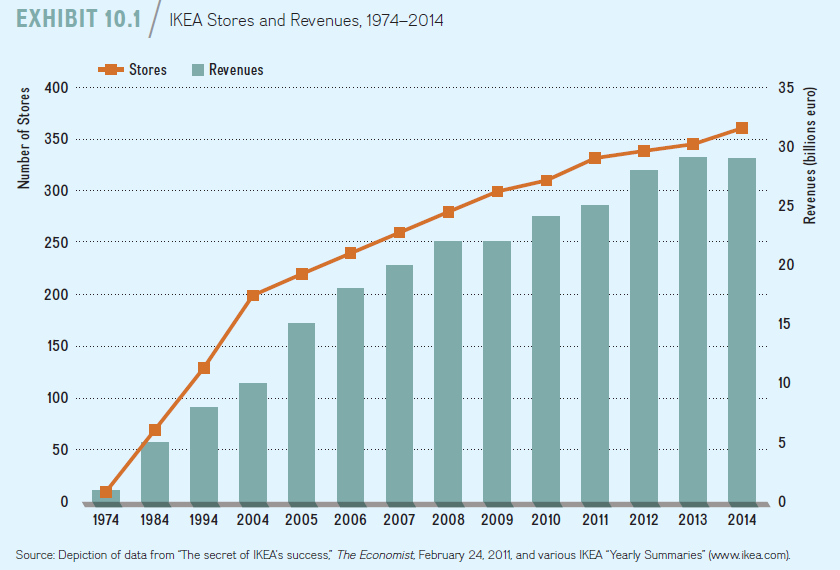Question
DESPITE ITS TREMENDOUS success, IKEA faces significant external and internal challenges going forward. Opening new stores is critical to drive future growth (see Exhibit 10.1).
DESPITE ITS TREMENDOUS success, IKEA faces significant external and internal challenges going forward. Opening new stores is critical to drive future growth (see Exhibit 10.1). Finding new sources of supply to support more store openings, however, is a significant challenge. Although demand for IKEA?s low-cost home furnishings increased during the global financial crisis as more customers became price conscious, IKEA?s annual store growth has slowed to less than 10 new stores a year. This is because its global supply chain has become a bottleneck. IKEA has difficulty finding suppliers that are a strategic fit with its highly efficient operations. Related to this issue is the fact that wood remains one of IKEA?s main input factors, and the world?s consumers are becoming more sensitive to the issue of deforestation and its possible link to global warming. In the near future, IKEA must find low-cost replacement materials for wood. In addition, powerful competitors have taken notice of IKEA?s success. Although IKEA is growing in North America, it holds less than 5 percent of the home furnishings market. To keep IKEA at bay in the United States, Target has recently recruited top designers and launched a wide range of low-priced furnishings. In some European markets, IKEA holds 30 percent market share.
Besides these external challenges, IKEA also faces significant internal ones. Since the company?s founding in 1943, no strategic decisions have been made without Kamprad?s involvement and explicit approval. In 2013, Kamprad (in his late 80s) stepped down from chairing Inter IKEA, the foundation that owns the company, and passed the position to one of his sons. Many observers compare Kamprad?s influence on IKEA?s culture and organization to that of the legendary Sam Walton at Walmart. Kamprad?s three sons will take on stronger leadership roles at IKEA.
Moreover, IKEA is privately held through a complicated network of foundations and holding companies in the Netherlands, Lichtenstein, and Luxembourg. This arrangement provides benefits in terms of reducing tax exposure, but also creates constraints in accessing large sums of capital needed for rapid global expansion. In addition, many EU countries as well as the United States have become increasingly more sensitive to the issue of tax avoidance schemes by large multinational enterprises. IKEA will need to address these challenges to live up to its strategic intent of doubling its number of yearly openings in an attempt to capture a larger slice of fast-growing markets such as the United States, China, and Russia.
Reference Exhibit-10.1

Ingvar Kamprad?s influence over IKEA may even be stronger than that of Sam Walton over Walmart because IKEA is privately held, while Walmart is a public company (since 1970). Walmart entered a period of difficulties after Sam Walton stepped down (in 1988 at age 70). Do you anticipate IKEA having similar leadership transition challenges? Why or why not?
EXHIBIT 10.1 IKEA Stores and Revenues, 1974-2014 Number of Stores 400 350 300 250 200 150 100 50 0 Stores Revenues 1974 1984 1994 2004 2005 2006 2007 2008 2009 2010 2011 2012 2013 2014 35 30 25 20 15 10 5 0 Source: Depiction of data from "The secret of IKEA's success. The Economist, February 24, 2011, and various IKEA "Yearly Summaries" (www.ikea.com). Revenues (billions euro)
Step by Step Solution
3.48 Rating (151 Votes )
There are 3 Steps involved in it
Step: 1
IK is a company that deals in the business of providing and manufacturing of low cost furniture to t...
Get Instant Access to Expert-Tailored Solutions
See step-by-step solutions with expert insights and AI powered tools for academic success
Step: 2

Step: 3

Ace Your Homework with AI
Get the answers you need in no time with our AI-driven, step-by-step assistance
Get Started


